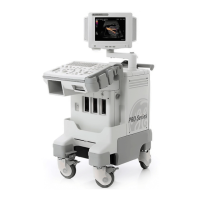GE MEDICAL SYSTEMS
2127661
LOGIQ 400 SERVICE MANUAL
7–20 PERIODIC MAINTENANCE
REV 5
7–3–6 When There’s Too Much Leakage Current...
Chassis Fails
Check the ground on the power cord and plug for continuity. Ensure the ground is not broken, frayed, or intermittent.
Replace any defective part.
Tighten all grounds. Ensure star washers are under all ground studs.
Inspect wiring for bad crimps, poor connections, or damage.
Test the wall outlet; verify it is grounded. Notify the user or owner to correct any deviations. As a work around, check
the other outlets to see if they could be used instead.
Note
No outlet tester can detect the condition where the white neutral wire and the green grounding wire
are reversed. If later tests indicate high leakage currents, this should be suspected as a possible
cause and the outlet wiring should be visually inspected.
Probe Fails
Test the probe in another transducer interface connector.
If excessive leakage current is slot dependent, inspect the Transducer Interface board for bent pins, poor connections,
and ground continuity.
If the problem still has stayed with the probe, replace the probe.
Peripheral Fails
Tighten all grounds. Ensure star washers are under all ground studs.
Inspect wiring for bad crimps, poor connections, or damage.
Still Fails
If all else fails, begin isolation by removing the probes, external peripherals, then the on board ones, one at a time while
monitoring the leakage current measurement.
New Unit
If the leakage current measurement tests fail on a new unit and if situation can not be corrected, submit a Safety Failure
Report to document the system problem. Remove unit from operation.

